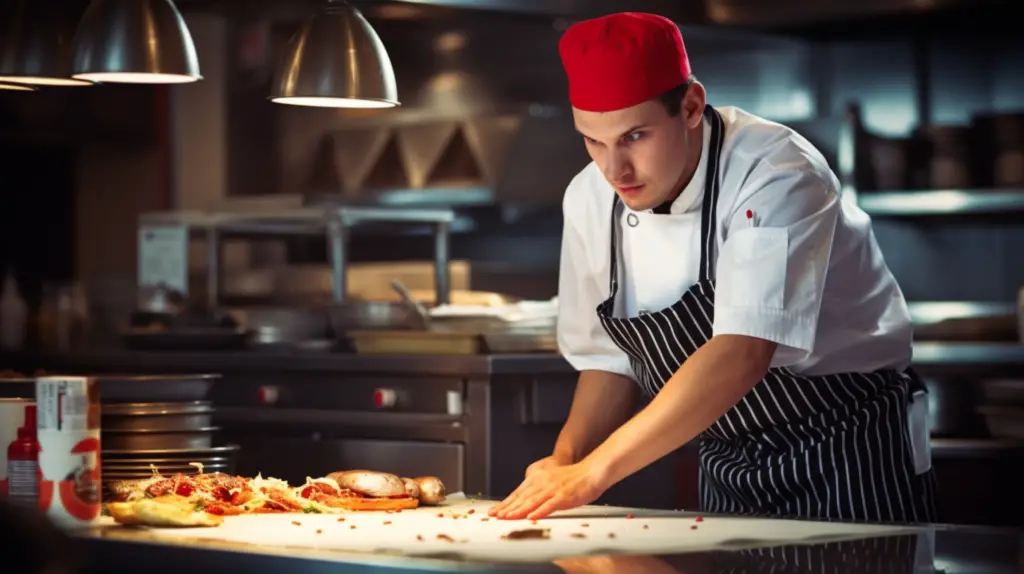To provide comprehensive insights into common food safety mistakes in restaurants and how to avoid them, we’ve gathered eight expert opinions from industry professionals, including Executive Chefs and Head Chefs. From the importance of avoiding cross-contamination with color-coded boards to maintaining the restaurant’s physical condition, this article offers a wealth of knowledge to ensure your restaurant operates safely and efficiently.
- Avoid Cross-Contamination with Color-Coded Boards
- Improve Hand Hygiene in the Kitchen
- Prevent Contamination from Cooks’ Conversations
- Implement Proper Cleaning Procedures
- Adopt the Freezer-Fryer Rule
- Ensure Proper Food Storage and Handling
- Pay Attention to Product Expiration Dates
- Maintain Restaurant’s Physical Condition
Avoid Cross-Contamination with Color-Coded Boards
Cross-contamination of ingredients when preparing or processing food items is one of the most common mistakes for food safety in restaurants. Using color-coded cutting boards will help minimize possible contamination considerably. Posting charts on walls with the respective colors for each board and training all staff on this matter is paramount to achieving a safer food environment.
Nelson Millan, Executive Chef, Vaquero Club
Improve Hand Hygiene in the Kitchen
One mistake restaurants must make for food safety is adequate hand hygiene in the kitchen. This can cause the spreading of harmful bacteria and many food-borne diseases. There are many ways to overcome this mistake.
For example, you can provide thorough training to your kitchen staff on proper handwashing, promoting the importance of hygiene in preventing food contamination. Encourage kitchen staff to wash their hands, especially after handling raw meat, chicken, and seafood. Ensure that wash basins are easily accessible in the kitchen and soaps and hand sanitizers are available.
Besides handwashing, educate the staff to use disposable gloves and to change them regularly. Moreover, conduct regular inspections to ensure hygiene protocols are up to the mark. By prioritizing proper hand hygiene, restaurants can significantly reduce the risk of foodborne illnesses and maintain a safe and clean kitchen environment.
Rob Smith, Head Chef, Your Private Chef
Prevent Contamination from Cooks’ Conversations
It’s risky to have people cooking meals without masks. Humans are social beings, so it’s hard not to talk while you work together.
However, it could be more hygienic to be speaking over meals you’re about to serve. This exposes food items to germs from saliva. For this very reason, cooks should take a few days off if they feel like they have the flu.
Restaurants can be havens for contracting viral infections.
Nancy Mitchell, Registered Nurse and Contributing Writer, Assisted Living Center
Implement Proper Cleaning Procedures
I remember my first kitchen job at a restaurant. One of the major mistakes some restaurants make for food safety is not following proper cleaning procedures. The restaurant kitchen was rarely sanitized, which was an enormous problem. Even though it made my job harder, it put customers at risk for food-borne illnesses.
Restaurants should create and implement a thorough cleaning schedule to avoid this mistake. This includes cleaning up after spills immediately, ensuring all surfaces are wiped down regularly, and washing hands regularly. Having a set schedule can help ensure the restaurant is always following proper cleaning procedures and keep customers safe.
Vincent Zhu, CEO and Founder, ShineACS Locks
Adopt the Freezer-Fryer Rule
The biggest mistake I see restaurants make is not keeping food outside the ‘danger zone’ for bacterial growth. This danger zone is between 40 °F and 140 °F, where bacteria thrive. Keeping food in this temperature range is the most common cause of food poisoning.
This is why I like to use the Freezer-Fryer Rule. The Freezer-Fryer Rule states that any food item should either be in the freezer or on the stove, but it should never sit on a countertop or out in the open.
Scott Lieberman, Owner, Touchdown Money
Ensure Proper Food Storage and Handling
Proper food storage and handling practices are essential for maintaining restaurant food safety standards. This includes ensuring food is stored at the correct temperatures during refrigeration and preparation to prevent bacterial growth.
To prevent cross-contamination, the staff should follow strict hygiene protocols, such as frequent handwashing. To avoid these mistakes, restaurants should implement rigorous training programs for their staff, emphasizing the importance of proper food storage and handling. Regular inspections and audits can help ensure compliance with these practices, ultimately safeguarding the health of customers and the establishment’s reputation.
Joe Acosta, Digital Marketing Manager, BBQ Galore
Pay Attention to Product Expiration Dates
This is one of the obvious mistakes restaurants usually make for monitoring the expiration of items. It often happens that authorities apprehend restaurant owners over this mistake. This problem occurs because the product’s expiration date is often removed with the original packaging and thrown away.
This makes the product vulnerable, and staff need clarification if they are using the right product. To avoid this mistake, restaurant owners must keep the expiration tag on the product. They should keep the product in its original packaging. This will let them check the expiration date of the product.
Greg Rozdeba, Co-Founder and CEO, Dundas Life
Maintain Restaurant’s Physical Condition
The place where you establish your restaurant, especially the condition of the interiors, can negatively affect your safe food handling practices. A prominent place where this is noticeable is on the walls and flooring of the eatery. For example, chipped areas or cracks on the surface are more likely to occur if your restaurant is in an older building. Leaving this condition as it is would be a significant mistake. These cracks and crevices are breeding grounds for pests and bacteria.
To fix this problem, invest in a sealant instead of temporarily closing off these sections with wallpaper and plastic. Seal all the holes, gaps, and broken areas with the weather-foam solution. If the cracks are too many or located in odd places you cannot reach, you can hire professionals for wall and floor repairs.
Loretta Kilday, DebtCC Spokesperson, Debt Consolidation Care

